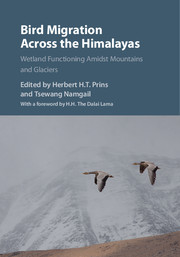Book contents
- Bird Migration Across the Himalayas
- Frontispiece
- Bird Migration Across the Himalayas
- Copyright page
- Contents
- Contributors
- Foreword
- Preface
- Introduction
- Part I Migratory Routes and Movement Ecology
- 1 Goose Migration across the Himalayas: Migratory Routes and Movement Patterns of Bar-headed Geese
- 2 Himalayan Thoroughfare: Migratory Routes of Ducks over the Rooftop of the World
- 3 Migratory Routes across the Himalayas Used by Demoiselle Cranes
- 4 Passerine Migration across the Himalayas
- 5 Wader Migration across the Himalayas
- 6 Raptor Migration across and around the Himalayas
- 7 Steppe Eagle Migration from Mongolia to India
- 8 Peregrine Falcons Crossing the ‘Roof of the World’
- Part II Physiography of the Highest Barrier on Earth
- Part III High-Altitude Migration Strategies
- Part IV People and Their Effects on the Himalayas
- Part V Conclusions
- Appendix: Selected Articles of the ‘Central Asian Flyway Action Plan’
- Gazetteer
- Index
- Plate section
- References
1 - Goose Migration across the Himalayas: Migratory Routes and Movement Patterns of Bar-headed Geese
from Part I - Migratory Routes and Movement Ecology
Published online by Cambridge University Press: 20 April 2017
- Bird Migration Across the Himalayas
- Frontispiece
- Bird Migration Across the Himalayas
- Copyright page
- Contents
- Contributors
- Foreword
- Preface
- Introduction
- Part I Migratory Routes and Movement Ecology
- 1 Goose Migration across the Himalayas: Migratory Routes and Movement Patterns of Bar-headed Geese
- 2 Himalayan Thoroughfare: Migratory Routes of Ducks over the Rooftop of the World
- 3 Migratory Routes across the Himalayas Used by Demoiselle Cranes
- 4 Passerine Migration across the Himalayas
- 5 Wader Migration across the Himalayas
- 6 Raptor Migration across and around the Himalayas
- 7 Steppe Eagle Migration from Mongolia to India
- 8 Peregrine Falcons Crossing the ‘Roof of the World’
- Part II Physiography of the Highest Barrier on Earth
- Part III High-Altitude Migration Strategies
- Part IV People and Their Effects on the Himalayas
- Part V Conclusions
- Appendix: Selected Articles of the ‘Central Asian Flyway Action Plan’
- Gazetteer
- Index
- Plate section
- References
Information
- Type
- Chapter
- Information
- Bird Migration across the HimalayasWetland Functioning amidst Mountains and Glaciers, pp. 15 - 29Publisher: Cambridge University PressPrint publication year: 2017
References
Accessibility standard: Unknown
Why this information is here
This section outlines the accessibility features of this content - including support for screen readers, full keyboard navigation and high-contrast display options. This may not be relevant for you.Accessibility Information
- 4
- Cited by
